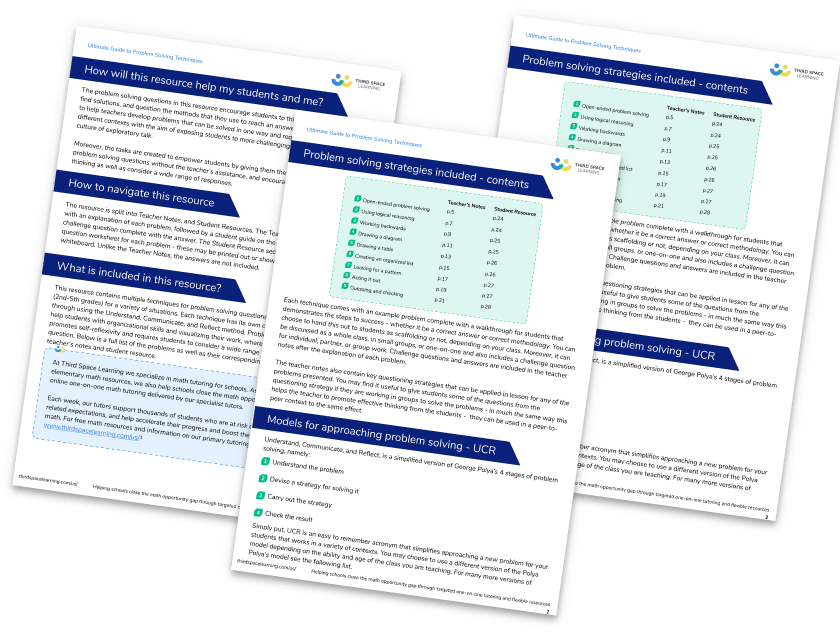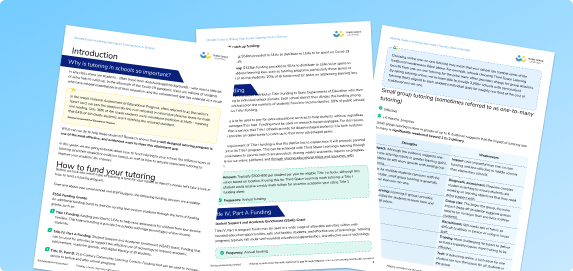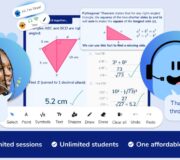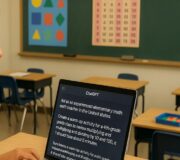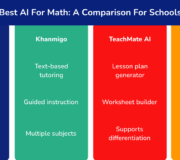How Education Technology Supercharges Our Math Tutoring And How You Can Use It Too
Education Technology – from the blackboards of the 1800s through to the AI headsets of today, edtech has had a rich and varied history. So much has changed about the way we teach our students in such a short space of time, and with no sign of the technological juggernaut letting up any time soon, it is important that modern teachers remain aware of the latest goings on.
Here at Third Space Learning, we are honored to be able to teach up to 7,000 students per week using our platform, but with such a large number of young minds relying on our one to one interventions for a math boost, it is crucial that we ensure our technology is at the cutting edge of what is possible within a school environment.
We know that schools are working within very tight restrictions including budgets, time and resources, and that is why we are passionate about using technology as a way to make teachers’ lives easier and help learners gain confidence and results in math!
- The OET Is Getting Serious About Education Technology
- Technology’s Role In A 21st Century Classroom – Leveraging Our Platform To Make A Difference In Schools
- Improving Engagement Amongst Students
- Improving Knowledge Retention Due To An Increase In Engagement
- Encouraging Individual Learning Through Personalized Experiences
- Freeing Up Time And Providing Support For Some Of The Busiest People In The World …Teachers!
- Teaching Useful Skills For The 21st Century
- The Magic Behind The Scenes: How We Use Our Education Technology To Bring Math Teaching Into The 21st Century
- Using Technology To Create An Engaging Platform For Students
- Saving Teachers Time Using Technology – Helping To Find A Work/Life Balance
- What Is Coming Up – Our Plans To Further Use Education Technology To Constantly Improve The Third Space Platform
High Impact Tutoring Guide for Schools
An in-depth review of the most popular tutoring approaches to help you choose the most effective one for your school
Download Free Now!The OET Is Getting Serious About Education Technology
In spring 2017, the U.S. Department of Education’s Office of Educational Technology (OET) released an update to the National Education Technology Plan, where they discuss reimagining the role of technology in education.
The OET discusses that the National Education Technology Plan is, “… a common vision and action plan that responds to an urgent national priority. It describes specific actions the United States should take to ensure learners of all ages have opportunities for personal growth and prosperity and remain competitive in a global economy.” These actions include opportunities in:
• Learning – Engaging and Empowering Learning through Technology
• Teaching – Teaching with Technology
• Leadership – Creating a Culture and Conditions for Innovation and Change
• Assessment – Measuring for Learning
• Infrastructure – Enabling Access and Effective Use
These five opportunities form the foundation of our goals and aims here at Third Space Learning, and to achieve them we have carefully considered how our technology should be used in the classroom.

Meet Skye, the voice-based AI tutor making math success possible for every student.
Built by teachers and math experts, Skye uses the same pedagogy, curriculum and lesson structure as our traditional tutoring.
But, with more flexibility and a low cost, schools can scale online math tutoring to support every student who needs it.
Find out more
Technology’s Role In A 21st Century Classroom – Leveraging Our Platform To Make A Difference In Schools
Ever since the handheld calculator was introduced into classrooms in the 1970s, there has been a debate over whether or not technology should have a place within schools and if so, to what extent.

Whilst there is, and probably always will be, an aversion to education technology as a teaching strategy and aid by some teachers, the vast majority of studies show that when used correctly, technology in the classroom can lead to a more productive classroom environment.
As Joyce Waddell said in her post for Michigan State University, “Technology can… be seen as both a tool and catalyst for change”, and this is something we are very passionate about here at Third Space Learning.
Never more so has the topic of technology in education been at the forefront than in the wake of the Covid-19 pandemic and resulting school closures and remote and blended learning that teachers and students alike were thrown into, practically overnight.
Due to its vast and varying nature, the use of technology in the classroom can result in a positive change in the learning environment and student performance in a wide number of ways. They include:
Improving Engagement Amongst Students
By introducing new technologies into the classroom, no matter which forms they come in, students are far more likely to be engaged with the topic they are learning.
Technology tools provide you, as a teacher, with the chance to make learning fun in new and alternative ways, from gamification through to taking students on virtual school trips using the interactive whiteboard or projector.
By using technology, something which the current generation of elementary school students have grown up with, in all of its varying forms, you may be able to encourage more active participation in the learning process which can be difficult to do in a more traditional educational setting.
For extra reading on this topic, take a look at how students’ attitude towards math can affect their confidence in the topic and lesson outcomes.
How Third Space Learning Uses Education Technology To Do This: Our tutors are trained to encourage student engagement and in turn, student learning. They do this through a combination of 1-to-1 conversation and by utilizing the interactive platform.
Students are asked about their favorite topics (outside of math, of course) at the beginning of their sessions and are then rewarded with images of football players, cakes or whatever else they may be interested in as the lesson goes on.
This small gesture encourages them to engage with their tutor as they feel that they are not only learning math, but having a discussion with a friend as they do so.
Improving Knowledge Retention Due To An Increase In Engagement
Students who are engaged in what they are learning have a much better chance at retaining knowledge compared to their peers who are not as engaged. The adaptive nature of technology means that it can be used for students of all ages and abilities to help them get the most from their education.
Once you have found that golden bullet, the thing that helps that one target student retain knowledge and truly learn it, you should embrace it whether it came from a technological source or not.
How Third Space Learning Uses Education Technology To Do This: The methods we use to engage students in the lesson means that they will retain the knowledge to a much better extent then they otherwise might.
With the opportunity to speak to the students on a 1-to-1 basis, our tutors are able to make sure that the ordinary distractions that can come in a classroom, such as friends and external factors, are removed and full focus and engagement are with the lesson.
Encouraging Individual Learning Through Personalized Experiences
One of the things we are dedicated to here at Third Space Learning is giving students the chance to learn in the way that best suits them. As all teachers know, no two students are the same, so we believe that the way they learn should match this.
Our tutors are trained to personalize lessons to get the best results from each session, and although this can be much trickier to do in a classroom with 30 students in it, if you find a way to bring a small element of that child’s personality into the way they are taught through a gamified computer task, a personalized math adventure on the computer, or highly personalized 1 to 1 math lesson, you will reap the rewards.
How Third Space Learning Uses Education Technology To Do This: Each and every lesson we teach is personalized to the student that is taking part. If a child is taking slightly longer to learn something than their peers, the tutor will adapt the lesson to ensure that they have secured that particular piece of knowledge.
Every student learns in a different way, and thanks to the individuality afforded to us by the types of educational technology we use, we can ensure that we find the right way for every student every time.
Freeing Up Time And Providing Support For Some Of The Busiest People In The World …Teachers!
Time is one of the most precious things in an elementary school classroom, and with distractions, questions and queries coming from all angles throughout the day, it can be tricky to even catch your breath as a teacher.
Fortunately, the implementation of technology in the classroom has enabled teachers to have a chance to catch up on grading, speak to individual children or simply grab a much needed cup of coffee. If used correctly, technology should benefit both your students and you.
How Third Space Learning Uses Education Technology To Do This: Weekly and long-term progress reports mean that teachers will be kept up to date with how their students are progressing through their Third Space Learning sessions, all without them having to mark anything.
With reports going straight into teachers inboxes on a regular basis, the marking pen can be left in the pot! Education technology definitely saves the day here!
Teaching Useful Skills For The 21st Century
While most elementary school aged children are more than adept at using technology by the time they arrive in the grade school classroom, perfecting these skills is crucial to ensure that they are adaptable to the working world later in life.
Elementary students may take being able to use spreadsheets and tablets for granted by the time they leave for middle school, but without learning how to make the most of them in their formative years, they could be playing catch up!
How Third Space Learning Uses Education Technology To Do This: In addition to learning math skills, children will also be engaging in digital learning by using computers and laptops to communicate with people in real-time in a safe manner.
Speaking to people who are not in the room and may be some distance away is common not only in the workplace, but also in higher education via distance learning and online courses. Meetings, lectures, seminars, among many other key experiences, are decreasingly in-person and increasingly online.
By introducing students to this concept, we are preparing students for what is to come in later life.
—-
Looking for more detail on our one to one math interventions?
If you want to review how we can help you bring more technology into your classroom and find out how we achieve 28 weeks progress in 14 weeks for 5th graders, book a demo with our schools team today. It takes 10 minutes over the phone and they’ll be happy to show you how we can help raise math attainment in your school using our platform.
—
The Magic Behind The Scenes: How We Use Our Education Technology To Bring Math Teaching Into The 21st Century
Over the last 9 years, we have been constantly improving our one to one math tutoring to ensure that while the functionality of the platform and educational materials provided are engaging and fun for students, they also help build students’ confidence in math and support teachers in the classroom.
To do this we have used technology in a number of ways, some of which our Third Space Learning students see everyday when they log in to the platform, and others of which are hidden in the behind the scenes, enabling us to do what we do so well!
Using Technology To Create An Engaging Platform For Students
One of the most important elements of our math interventions is their one-on-one nature. We have brought together the worlds of technology and face to face teaching, and combined them to create a product that is loved by 1000’s of teachers and students.
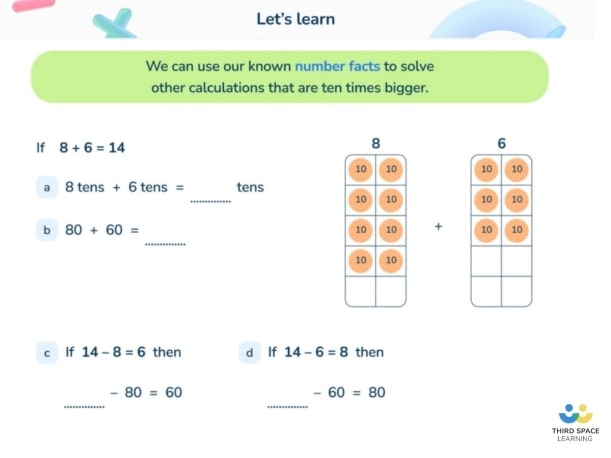
Rather than simply having students work their way through a series of questions on any given topic, our tutors are there with them every step of the way, offering encouragement and incentives to solve the math problem on their own. The importance of education technology in this regard can not be underestimated.
In their low or high-dosage tutoring session, students share an interactive screen with their tutor, communicating through a headset and working their way through the specially selected lesson. Rewards are evident throughout the journey, with effort points and images of their favorite sports, animals and more shown by the tutor.
The interactive nature of the lessons is something that students thoroughly enjoy, as it brings their love of technology into the classroom. Teaching one student gives us the chance to personalize their learning experience and encourage individual learning, and this is a fantastic way to fill any gaps and cement learning amongst targeted students.
Saving Teachers Time Using Technology – Helping To Find A Work/Life Balance
Grading, at least for Third Space Learning sessions, is a thing of the past. Our intelligent platform generates progress reports on how each individual student is doing in their sessions, and these are a great way for teachers to check and judge progress at a glance.
These reports are sent on a weekly basis and on-demand alongside longer-term progress reports and overviews, so as a teacher you will have a view of how Third Space Learning sessions as a whole are progressing, not just single sessions at a time.
On occasion, if the lessons are not producing the results we want them to, in terms of student attainment, we make the appropriate changes to ensure that they do.
The power of the huge amount of data we have at our fingertips enables us to do this at a level that is unmatched by individual schools and other tutoring platforms, and it is this data that presents us with an opportunity to analyze, adapt and improve the platform to ensure that we remain at the cutting edge of education technology.
What Is Coming Up – Our Plans To Further Use Education Technology To Constantly Improve The Third Space Platform
The goal for everyone here at Third Space Learning is to create an intuitive platform that is not only affordable for schools, but also easy for them to use. In order to achieve this, we are constantly acting on feedback and seeking ways to improve the user experience.
Monitoring such a vast number of one to one, unique math lessons each week is a challenge, and it is one that we are tackling with the help of Artificial Intelligence. The system behind the platform that schools see learns how to improve from each and every session that takes place, and this has resulted in one to one math interventions that you know will always be improving.
As well as an A.I system that can automatically pair each student with their ideal lesson, we pay close attention to our tutors and the way they teach the lessons. Voice recognition software will soon be helping us prevent one way conversations between tutors and students, and to ensure that our tutors continue to engage each and every student in every session.
We are always working to improve the way we use education technology to support teachers and students, and the things discussed in this blog are only the tip of the iceberg. Find out about AI in education and how schools are using AI tutoring and AI for math here, including the best AI for math according to teachers like you.
There is plenty more to come from the Third Space Learning platform, so keep your eyes peeled for our latest updates. But if you would like to learn more about how our platform can help students in your school boost their confidence and results in math, find out more here.
Read more: Find out what essential ingredients you need for a truly great math intervention and learn more about traditional vs AI tutoring and how we are harnessing the power of both in our interventions
Do you have students who need extra support in math?
Skye—our AI math tutor built by experienced teachers—provides students with personalized one-on-one, spoken instruction that helps them master concepts, close skill gaps, and gain confidence.
Since 2013, we’ve delivered over 2 million hours of math lessons to more than 170,000 students, guiding them toward higher math achievement.
Discover how our AI math tutoring can boost student success, or see how our math programs can support your school’s goals:
– 3rd grade tutoring
– 4th grade tutoring
– 5th grade tutoring
– 6th grade tutoring
– 7th grade tutoring
– 8th grade tutoring
The content in this article was originally written by a member of the content team Connor Whelan and has since been revised and adapted for US schools by elementary math teacher Christi Kulesza.
